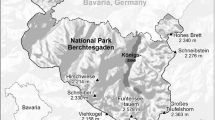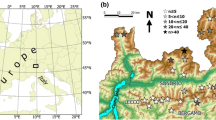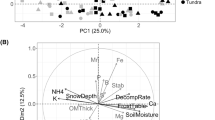Abstract
The altitudinal gradient is considered as a stress gradient for plant species because the development and fitness of plant communities tend to decrease as a result of the extreme environmental conditions present at high elevations. Abiotic factors are predicted to be the primary filter for species assemblage in high alpine areas, influencing biotic interactions through both competition for resources and positive interactions among species. We hypothesised that the relative importance of the ecological driving forces that affect the biotic interactions within plant communities changes along an elevation gradient on alpine debris slopes. We used multiple gradient analyses of 180 vegetation plots along an altitudinal range from ~1,600 to 2,600 m and single 100 m-bands in the Adamello-Presanella Group (Central Alps) to investigate our hypothesis; we measured multiple environmental variables related to different ecological driving forces. Our results illustrate that resource limitations at higher elevations affect not only the shift from competition to facilitation among species. A geomorphological disturbance regime along alpine slopes favours the resilience of the high-altitude species within topographic/geomorphological traps. An understanding of the ecological driving forces and positive interactions as a function of altitude may clarify the mechanisms underlying plant responses to present and future environmental changes.




Similar content being viewed by others
References
Baroni C, Carton A, Seppi R (2004) Distribution and behaviour of rock glaciers in the Adamello-Presanella Massif (Italian Alps). Permafr Periglac 15:243–259
Baroni C, Armiraglio S, Gentili R, Carton A (2007) Landforms-vegetation units for recostructing the geomorphologic evolution of composite alpine debris cones (Valle dell’Avio, Adamello Group, Italy). Geomorphology 84:59–79
Baroni C, Armiraglio S, Gentili R (2013) Vegetation analysis on composite debris cones. In: Bollschweiler M, Stoffel M Miklau FR (eds) Tracking torrential processes on fans and cones. Advances in Global Change Research, vol 47. Springer, Dordrecht, p 187–201
Becker A, Körner C, Brun JJ, Guisan A, Tappeiner U (2007) Ecological and land use studies along elevational gradients. Mt Res Dev 27:58–65
Bertness J, Callaway RM (1994) Positive interactions in communities. Trends Ecol Evol 9:191–193
Boggs K, Klein SC, Grunblatt J, Boucher T, Koltun B, Sturdy M, Streveler GP (2010) Alpine and subalpine vegetation chronosequences following deglaciation in coastal Alaska. Arct Antarct Alp Res 42:385–395
Brooker RW, Callaghan TV (1998) The balance between positive and negative plant interactions and its relationship to environmental gradients: a model. Oikos 81:196–207
Brooker RW, Maestre FT, Callaway RM, Lortie CL, Cavieres LA et al (2008) Facilitation in plant communities: the past, the present, and the future. J Ecol 96:18–34
Bruno JF, Stachowicz JJ, Bertness MD (2003) Inclusion of facilitation into ecological theory. Trends Ecol Evol 18:119–125
Butterfield BJ (2009) Effects of facilitation on community stability and dynamics: synthesis and future directions. J Ecol 97:1192–1201
Caccianiga M, Luzzaro A, Pierce S, Ceriani RM, Cerabolini B (2006) The functional basis of a primary succession resolved by CSR classification. Oikos 112:10–20
Caccianiga M, Andreis C, Diolaiuti G, D’Agata C, Mihalcea C, Smiraglia C (2011) Alpine debris-covered glaciers as a habitat for plant life. Holocene 21:1011–1020
Callaway RM, Walker LR (1997) Competition and facilitation: a synthetic approach to interactions in plant communities. Ecology 78:1958–1965
Callaway RM, Brooker RW, Choler P, Kikvidze Z, Lortie CJ, Michalet R, Paolini L, Pugnaire FI, Newingham B, Aschehoug ET, Armas C, Kikodze D, Cook BJ (2002) Positive interactions among alpine plants increase with stress. Nature 417:844–848
Callegari E, Brack P (2002) Geological map of the Tertiary Adamello batholith (Northern Italy). Explanatory notes and legend. Mem Sci Geol 54:19–49
Cerabolini BEL, Brusa G, Ceriani RM, De Andreis R, Luzzaro A, Pierce S (2010) Can CSR classification be generally applied outside Britain? Plant Ecol 210:253–261
Conti F, Abbate G, Alessandrini A, Blasi C (2005) An annotated checklist of the Italian vascular flora. Palombi Editore, Roma
Deffossez E, Courbaud B, Marcais B, Thuiller W, Granda E, Kunstler G (2011) Do interactions between plant and soil biota change with elevation? A study on Fagus sylvatica. Biol Lett 7:699–701
Ellenberg H (1974) Zeigerwerte der Gefässpflanzen Mitteleuropas. Scripta Geobot. 9. Göttingen, Germany
Erschbamer B (2007) Winners and losers of climate change in a central alpine glacier foreland. Arct Antarct Alp Res 39:237–244
Erschbamer B, Kiebacher T, Mallaun M, Unterluggauer P (2009) Short-term signals of climate change along an altitudinal gradient in the South Alps. Plant Ecol 202:79–89
Gentili R, Armiraglio S, Rossi G, Sgorbati S, Baroni C (2010) Floristic patterns, ecological gradients and biodiversity in the composite channels (Central Alps, Italy). Flora 205:388–398
Grime JP (1977) Evidence for the existence of three primary strategies in plants and its relevance to ecological evolutionary theory. Am Nat 111:1169–1194
Grime JP (2001) Plant strategies, vegetation processes, and ecosystems properties, 2nd edn. Wiley, Chichester
Holmgren M, Scheffer M (2010) Strong facilitation in mild environments: the stress gradient hypothesis revisited. J Ecol 98:1269–1275
Kienast F, Wildi O, Brzeziecki B (1998) Potential impact of climate change on species richness in mountain forest—an ecological risk assessment. Biol Conserv 83:291–305
Klimeš L (2003) Life-forms and clonality of vascular plants along an altitudinal gradient in E Ladakh (NW Himalayas). Basic Appl Ecol 4:317–328
Körner C (2007) The use of “altitude” in ecological research. Trends Ecol Evol 22:569–574
Kullman L (2002) Rapid recent range-margin rise of tree and shrub species in the Swedish Scandes. J Ecol 90:68–77
Maestre FT, Callaway RM, Valladares F, Lortie CJ (2009) Refining the stress-gradient hypothesis for competition and facilitation in plant communities. J Ecol 97:199–205
Martens SN, Breshears DD, Barnes FJ (2001) Development of species dominance along elevational gradient: population dynamics of Pinus edulis and Juniperus monosperma. Int J Plant Sci 162:777–783
Müller-Schneider P (1986) Verbreitungsbiologie der Blütenpflanzen Graubündens. Veröffentlichungen des Geobotanischen Institutes der ETH Stiftung Rübel, Zürich 85, pp 1–263
Nogués-Bravo D, Araújo MB, Romdal T, Rahbek C (2008) Scale effects and human impact on the elevational species richness gradients. Nature 453:216–220
Odland A (2009) Interpretation of altitudinal gradients in South Central Norway based on vascular plants as environmental indicators. Ecol Indic 9:409–421
Oksanen L, Ranta E (1992) Plant strategies along mountain vegetation gradients: a test of two theories. J Veg Sci 3:175–186
Pellissier L, Fournier B, Guisan A, Vittoz P (2010) Plant traits co-vary with altitude in grasslands and forests in the European Alps. Plant Ecol 211:351–365
Pérez FL (1998) Conservation of soil moisture by different stone covers on alpine talus slopes (Lassen, California). Catena 33:155–177
Raffl C, Mallaun M, Mayer R, Erschbamer B (2006) Vegetation succession pattern and diversity changes in a glacier valley, Central Alps, Austria. Arct Antarct Alp Res 38:421–428
Restrepo C, Walker LR, Shiels AB et al (2009) Landsliding and its multiscale influence on mountainscapes. Bioscience 59:685–698
Sanjerehei MM, Jafari M, Mataji A, Meybodi NB, Bihamta MR (2011) Facilitative and competitive interactions between plant species (an example from Nodushan rangelands, Iran). Flora 206:631–637
Sardinero S (2000) Classification and ordination of plant communities along an altitudinal gradient on the Presidential Range, New Hampshire, USA. Plant Ecol 148:81–103
Theurillat J-P, Guisan A (2001) Potential impact of climate change on vegetation in the European Alps: a review. Clim Change 50:77–109
Tilman D (1982) Resource competition and community structure, monographs in population biology. Princeton University Press, Princeton
Turner MG (2010) Disturbance and landscape dynamics in a changing world. Ecology 91:2833–2849
Vittoz P, Engler R (2007) Seed dispersal distances: a typology based on dispersal modes and plant traits. Bot Helvetica 117:109–124
Vittoz P, Camenisch M, Mayor R, Miserere L, Vust M, Theurillat J-P (2010) Subalpine-nival gradient of species richness for vascular plants, bryophytes and lichens in the Swiss Inner Alps. Bot Helvetica 120:139–149
Wamelink GWW, Joosten V, van Dobben HF, Berendse F (2002) Validity of Ellenberg indicator values judged from physico-chemical field measurements. J Veg Sci 13:269–278
Acknowledgments
This research was supported by the Università of Milano-Bicocca, Università of Pisa, Museo di Scienze Naturali di Brescia and by the Italian MIUR Project (PRIN 2010-11): “Response of morphoclimatic system dynamics to global changes and related geomorphological hazards” (national and local coordinator C. Baroni). The authors would like to thank the anonymous reviewers for their constructive comments which improved the quality of the paper.
Author information
Authors and Affiliations
Corresponding author
Electronic supplementary material
Below is the link to the electronic supplementary material.
Table ST1
Climatic data from 13 meteorological stations of the Adamello-Presanella Group. (XLS 28 kb)
Table ST2
Species, dispersal strategies (DS) and Grime’s CSR strategies. (XLS 51 kb)
Table ST3
List of species abbreviation (XLS 24 kb)
Table ST4
Contribution to dissimilarity (Bray–Curtis index), according to the SIMPER analysis of the first nine species per band and of the first 19 species for the whole altitudinal range. Abbreviations: see Table ST3. (XLS 22 kb)
Figure SF1
Whole set of the CCA analyses (for all altitudinal bands). (TIFF 2696 kb)
Rights and permissions
About this article
Cite this article
Gentili, R., Armiraglio, S., Sgorbati, S. et al. Geomorphological disturbance affects ecological driving forces and plant turnover along an altitudinal stress gradient on alpine slopes. Plant Ecol 214, 571–586 (2013). https://doi.org/10.1007/s11258-013-0190-1
Received:
Accepted:
Published:
Issue Date:
DOI: https://doi.org/10.1007/s11258-013-0190-1




